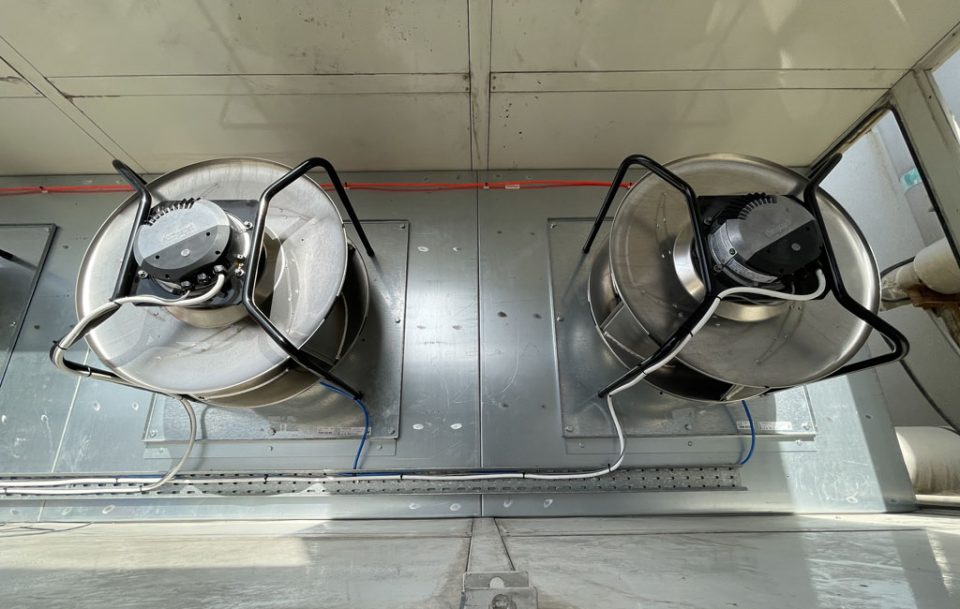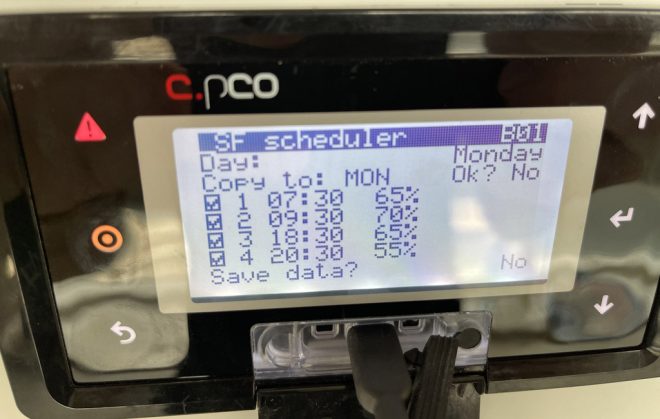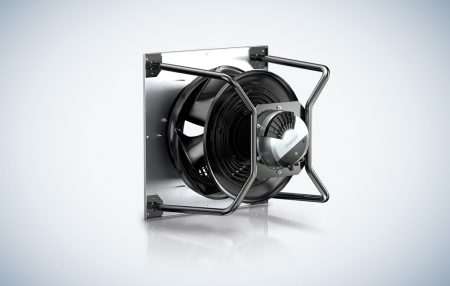The Swiss Tower is a 40-story high-rise building in Dubai that houses offices and luxury apartments (Fig. 1). The building is constantly supplied with fresh, cooled air from a total of four air handling units (AHUs). Each AHU is responsible for supplying fresh air to several floors and was previously equipped with belt-driven AC fans. The old systems were always running at full load, and there was no way to regulate them according to demand, which would have made sense due to the changing occupancy of the office spaces. The bottom line was that operation was costly and resulted in a high level of energy waste.

Fig. 1: The Swiss Tower in Dubai is an impressive high-rise in Dubai. (Fig. | ebm-papst)
For these problems, retrofitting the AHUs was both the most economical solution and the one that could best be implemented in the required time. The main requirement of the project was to reduce the power consumption of the fans and to exploit further energy saving potential by establishing a control system. The upgrade was also intended to extend the service life of the AHUs. The contract for the retrofit was awarded to Jon Davies and his company Qey Energy Solutions, which worked closely with ebm-papst Middle East and Taka Solutions to develop an efficient solution.
An efficient complete solution
In order to keep the downtime of the AHUs as short as possible during the retrofit work, they were upgraded one after the other. However, this meant that during the downtime, parts of the building could no longer be supplied with fresh air. This time pressure meant that the new fans had to be installed quickly and without complications. Qey’s “MatrixAir+ EC” solution made this possible. This fan package, consisting of EC fans, fan terminal boxes, fan bulkheads and control panels, was delivered directly to the AHUs as a pre-prepared complete solution and installed.
When it came to the first component, the choice fell on EC centrifugal fans from ebm-papst’s RadiPac series. Its compact design and low weight compared to a single large AC fan made the replacement easy and stress-free, as no heavy equipment was needed for installation – which saved time and money too. Since the RadiPac is supplied as a plug & play solution, commissioning the EC fan is also a quick process. A total of 26 RadiPacs were installed as FanGrids in the intake and exhaust sections of each of the four AHUs (Fig. 2).

Fig. 2: Instead of a single fan, FanGrids were installed in the four AHUs. The pre-prepared fan package makes installation quick and easy. (Fig. | ebm-papst)
FanGrid ensures operational reliability
A FanGrid consists of several small fans arranged next to or above one another and operated in parallel. This redundant design increases the dependability of the system and ensures greater operational reliability (Fig. 3). If one fan fails, the other EC fans compensate for the missing air volume. This provides the necessary reliability, especially for large systems, and even more so in particularly hot regions such as Dubai. Another reason for a FanGrid was to extend the system’s service life. This can be achieved by operating several small fans at partial load as required instead of one large fan constantly at full load.
Another advantage of this type of setup is that air can flow more evenly through upstream and downstream components such as filters and heat exchangers. This results in more efficient filtering of the air, as well as better heat transfer performance – which in turn reduces the operating costs of the system. Several small fans also usually require less installation space and are lighter than a single large fan, making replacement easier.

Fig. 3: In a FanGrid, the RadiPacs are installed next to or above one another and operated in parallel. This ensures particularly high operational reliability. (Fig. | ebm-papst)
Energy savings with EC technology
The main aim of the retrofit was to save energy, which is why a fan with an EC motor was chosen. Its high motor efficiency level of over 90% alone makes large savings possible compared to the AC motor. In addition, with the old AC fans, only two operating levels were possible: either they were off, or they were operated at maximum speed; there was nothing in between due to the lack of control electronics. This means that regardless of the actual occupancy of the building, all systems always ran at full power, even if at certain times it would have been sufficient to supply individual parts of the building with a lower air volume.
By contrast, EC fans can be continuously controlled between 0 and 100%, meaning that the speed can always be adjusted to meet demand. This results in significant potential for savings, as the power consumption increases or falls in line with the speed to the power of three (P~n³). So if the speed is reduced by half compared to the nominal speed, the power consumption is reduced by a factor of 8 and is therefore only 12.5 % of the rated output. If, on the other hand, half of the AC fans are switched off and the other half are still operated at full load, only 50% of the power consumption can be saved.

Fig. 4: The demand-based control system regulates the air volume flow depending on the time. (Fig. | ebm-papst)
Demand-based fresh air supply
The second part of the retrofit involved upgrading the control system. The Swiss Tower already had a building management system; the aim with regard to the ventilation systems was now to develop a time-dependent strategy for controlling them. One advantage was that, thanks to the security scans at the entrance and exit, data was already available on the building’s occupancy, which varied according to the time of day. Working with Taka Solutions, Qey used this data to determine the airflow requirements on a time-dependent basis and programmed an internal schedule using software developed specifically for retrofit projects (Fig. 4).
Office occupancy is lower in the mornings and evenings, which is why the power is reduced at these times, whereas during the afternoon the building is at its highest capacity, temperatures tend to be at their hottest, the AHUs have to deliver a greater volume of air, and there is the most demand for cooling (Fig. 5). The ideal prerequisite for this is the RadiPac’s RS485/MODBUS RTU interface, which enables the fans to be intelligently controlled while also allowing the operating data of each individual fan to be monitored. The RadiPac also enables differential pressure measurement, as it has a pressure tap for connecting a differential pressure transmitter. This also allows conclusions to be drawn about the air flow rate that is currently being handled. Thanks to the MODBUS interface, Qey’s software can monitor and control the speed as specified by the schedule, and also monitor the air flow, energy consumption and, if necessary, alarms and quickly initiate countermeasures.

Figure 5 / Characteristic curve: Here, the modulation of the air flow over the day can be seen thanks to the time-dependent control system. After the retrofit, the new peak demand is only 16.5 kW (previously 31 kW). (Fig. | ebm-papst)
Target achieved – energy consumption reduced by more than 60%
Documenting and monitoring the operating data are important for checking the energy savings achieved by the retrofit and can facilitate additional improvements to the control system in a further step. This is because after a certain time, during which the internal schedule is tested, further adjustments and refinement of the control system may be necessary. Constant monitoring of each individual fan also ensures reliability: problems can be identified quickly and negative consequences prevented at an early stage.

Fig. 6: The control electronics with RS485/MODBUS RTU interface are already integrated in the RadiPac. (Fig. | ebm-papst)
Finally, by monitoring and documenting the operating data, it is also possible to determine how much the retrofit has saved: The peak demand for the old motor was 31 kW. After the retrofit, the peak demand for the maximum air flow required is 16.5 kW. The demand-based control system has also meant that the new maximum power consumption is only used occasionally and when required, and no longer non-stop (Fig. 6). The combination of ebm-papst’s efficient RadiPac fans, Taka Solution’s extensive knowledge of building analysis, and Qey’s MatrixAir retrofit solution resulted in a successful project implementation. Energy consumption was reduced by more than 60%.

Leave a comment